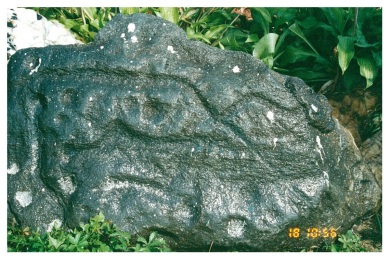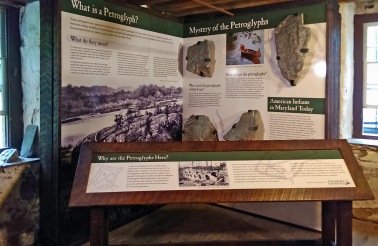By Charlie Hall, State Terrestrial Archeologist
From simple pecked cups, to grooved parallel lines, to complex diamond shapes and curvilinear compositions, the Susquehanna River’s Bald Friar petroglyphs have generated interest – and mystery – for hundreds of years. Native Americans originally carved the abstract images into large, island-sized boulders between what is now the Pennsylvania line and the Conowingo Dam. In 1927, the petroglyphs were removed from their location to save them from inundation from the dam, after which the Maryland Academy of Sciences cemented together the fragmented stones for exhibition. No one knows the precise age or meaning of the petroglyphs.
Now, in the historic Rock Run Grist Mill within view of the Susquehanna River, a new exhibit at Susquehanna State Park features some of the enigmatic artifacts, coupled with interpretative text. The exhibit is not large, but it deftly covers the mysterious history of these images carved in rock, as well as the more recent journey they have taken.
Spurred in part by a desire to present a more comprehensive picture of the Bay region and Native peoples, the Chesapeake Conservancy brought together the Maryland Department of Natural Resources to house the exhibit and the Maryland Historical Trust to execute a loan for the artifacts. Financing for the design and fabrication of the exhibit was provided by Turney McKnight, a member of the Chesapeake Conservancy’s Board of Directors. Turney has a deep and manifest interest in the petroglyphs, and his generosity (and good humor) literally took this exhibit from a great idea to a terrific product.
Although no one fully understands the Bald Friar petroglyphs, they were not randomly or casually positioned on the landscape. Placed between the lowest ford and the deepest “sink” within the falls of the Susquehanna River, their meaning must have been connected to that place. We may never know who made the images or when, or for whom the message was intended. We can be sure, however, that by bringing some of the petroglyphs to the bank of the Susquehanna River – only about 6 miles from their original location – Turney McKnight and the Chesapeake Conservancy have returned them to the place where that message resonates best.



What a great location to interpret this now submerged petroglyph site. I look forward to seeing the exhibit.
Looks like a map.
What are the dates and times that the petroglyphs will be on display? Will the exhibit be located at DNR’s headquarters at 580 Taylor Avenue in Annapolis?
The exhibit — located in the historic grist mill at Susquehanna State Park (not at the headquarters in Annapolis) — is open Saturdays and Sundays, 10 a.m. to 4 p.m., Memorial Day-Labor Day.
Barbara: I agree with you Dan, It’s too far from the ocean to be a whale but that is another option.
Fantastic decision to bring the petroglyphs closer to home……. there are still some fragments scattered around Harford and Cecil Counties.